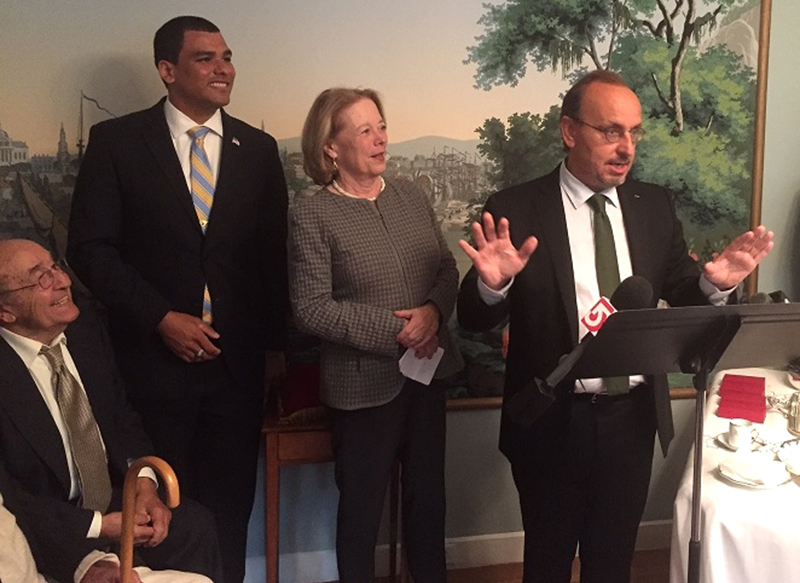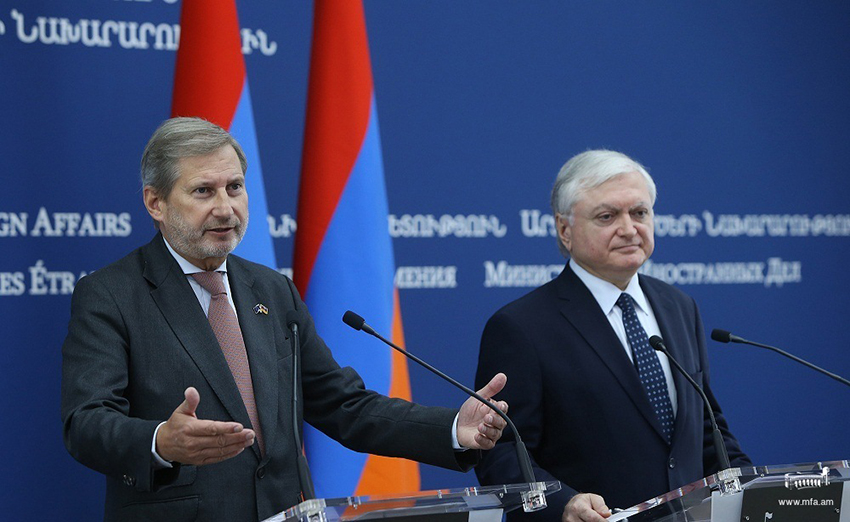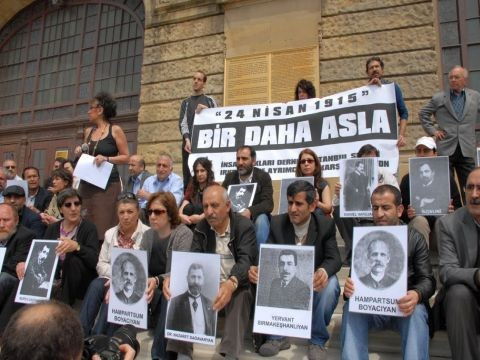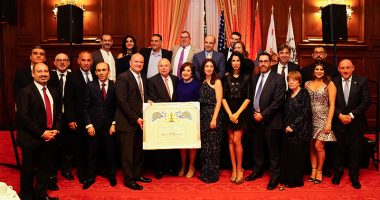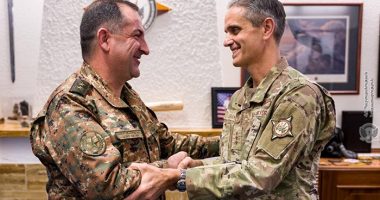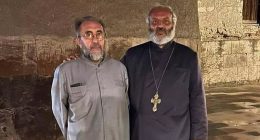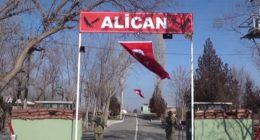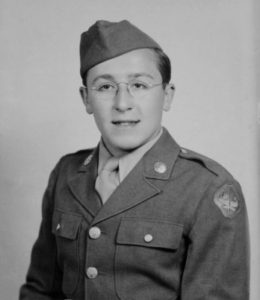

By Ludér Tavit Sahagian
On September 21, 2017, in the presence of MA Congresswoman Niki Tsongas and MA Secretary of Veterans’ Affairs Francisco Ureña, Consul General of France in Boston Valéry Freland decorated four WWII American veterans with the French Legion of Honor medal at a ceremony held at his residence. Of the four honorees, notably two were of Armenian descent: Mr. Avak Avakian of Concord, MA and this writer’s paternal grandfather, Mr. Charles Sahag Sahagian, of Needham Heights, MA.
According to the Consulate General’s official announcement, these veterans “were selected to be awarded the Legion of Honor for their bravery and heroism, and for their outstanding contribution to the liberation of France in World War II.” Established in 1802 by Emperor Napoleon Bonaparte, the Legion of Honor “is exclusively awarded in cases of exemplary military and civilian services. It is the oldest and highest honor in France. It is awarded by decree of the President of the French Republic, [in this instance by] Mr. Emmanuel Macron. Since the 60th anniversary of D-Day, France recognizes every year many American veterans of WWII for their courageous service.”
A native of Dorchester, MA, Pvt. Charles S. Sahagian “served as a rifleman and heavy weapons specialist in the 347th Regiment, 87th Division of the 3rd U.S. Army in the European Theater during 1944-45. While clearing German units in the Moselle region in France, General Patton ordered Sahagian’s battalion to immediately recapture the town of Saint-Hubert, Belgium. The resulting 30-hour march from France to Belgium was recognized as one of the fastest and furthest movements of infantry in U.S. army records! Honorably discharged in February 1946, [now Pfc.] Sahagian received the Purple Heart, three Bronze Star Medals, the WWII Victory Medal and the American Campaign Medal. [Following his military service, he] led an impressive career, serving as [the] U.S. Representative to NATO specializing in military materials research. He [also] served as a U.S. Representative to NASA [recommending materials experiments in space] and [for three decades] as a Supervisory Physicist for the U.S. Department of Defense.”
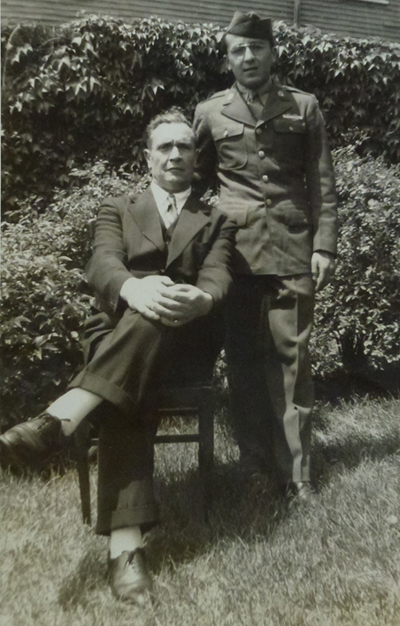

Charles S. Sahagian was born 91 years ago to Zarouhi Khoshabjian Sahagian and Sahag Bedros Sahagian. His parents hailed respectively from the cities of Digranagert and Kharpert in Western Armenia and were survivors of the Armenian Genocide.
He attended the Mather School in Dorchester, MA, the oldest public elementary school in the U.S., and Boston Latin School, the oldest public high school in the U.S. Interestingly, a few years following his military service, he attended the Graduate Program in Applied Physics at Harvard University, the oldest university in the U.S.
While still a teenager, he volunteered to serve in the U.S. Army. A few months later, he was assigned to the famous 3rd Army commanded by Gen. George S. Patton.
The fierce compulsion of Gen. Patton at the time to capture and neutralize the German forts protecting Metz, France, to then cross the Moselle and drive full-force to Berlin to precede the Soviets, was suddenly thwarted by a multi-division Nazi attack in the Ardennes that was personally mandated by Hitler. This massive onslaught is today known as the “Battle of the Bulge.”
It was during this period that Sahagian was introduced to and had to experience war at its worst. His division (the 87th) and other units still eliminating enemy resistance in the Metz sector were directed to advance immediately northward to help exhausted American troops in Bastogne, Belgium and to blunt the deadly German offensive. The resulting formidable forced march occurred under total radio silence. Over 130 miles under the worst possible winter conditions were traversed in less than two days.
Sahagian’s division moved clandestinely out of France, through Luxembourg, into Belgium. This silent operation has taken its place as one of the major tactical operations of WWII.
Gen. Patton, after sending armored units to insure Bastogne would not be recaptured, then ordered a precipitous, even reckless attack in a western arc around the strategic Belgian town, “with the 87th Division and 11th Armored carrying the load.” “Had I not attacked,” Gen. Patton reports in his memoirs, “it would have permitted the Germans to drive home their attack”, imperiling the lifeline into Bastogne that had been forged a few days earlier.
The “Battle of the Bulge” had been joined. The German High Command and the Allied Forces both realized that the winner of this battle would win the war.
On January 11, 1945, the inevitable orders came down from Gen. Patton; his 3rd Army “was to assault and recapture the key hub of Saint-Hubert, and thus insure the giant Ardennes offensive would go no further.” The lead assignment to take the town was given to Sahagian’s battalion (the 3rd Battalion, 347th Regiment). There was one caveat that Gen. Patton demanded in issuing his battle orders: no military units save the 347th were to participate in this operation.
Saint-Hubert was taken in two days. By early February 1945, the German offensive in the Ardennes had been beaten back and then some. After 40 days of continuous combat, Sahagian and his comrades were able to cross into Germany proper.


On the 42nd day, February 9, 1945, injured Sahagian was jeeped off the front lines on a stretcher. After a year of hospitalization in four countries, the young, now 19-year-old soldier returned to his family in Dorchester. As previously mentioned, he has been awarded many commendations and medals for his military bravery, also including the renowned Combat Infantryman Badge.
Sahagian can claim important career accomplishments following his military service. In addition to serving as a scientific consultant to NASA and NATO during the 1970s and 80s, he was appointed an Adjunct Associate Professor of Chemical Engineering at the University of Rhode Island in Kingston. Additionally, he was an Associate Editor of the International Journal of Crystal Growth, conducting peer reviews of articles, including those submitted by Armenian scientists from abroad. In a private 1963 meeting in Boston with his foster Needham High School student Daniel Jumah of Kenya, he had the opportunity to discuss several human rights issues with Dr. Martin Luther King, Jr., including the unaddressed Armenian Genocide. In 1972, the Armenian Academy of Sciences invited him to give the keynote speech at the Fourth All-Union Conference on Crystal Growth held in the resort town of Dzaghgatsor. In the mid-1990s, Sahagian organized the collection and delivery of several tons of gifts and school supplies under the auspices of the Cambridge-Yerevan Sister City Association to the children of Saroukhan, Armenia. A committed resident of the Town of Needham for over sixty years, he has served on numerous municipal committees, including most recently on Needham’s Human Rights Committee.
Ludér Tavit Sahagian is a MA-based writer specializing in international relations and diplomacy.

